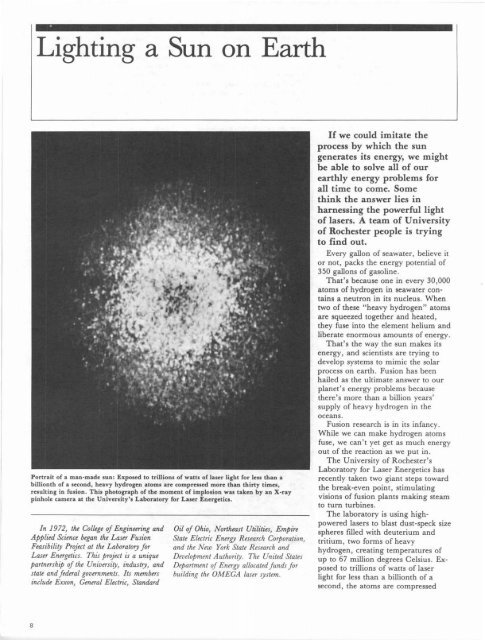Download PDF - University of Rochester Libraries
Download PDF - University of Rochester Libraries
Download PDF - University of Rochester Libraries
You also want an ePaper? Increase the reach of your titles
YUMPU automatically turns print PDFs into web optimized ePapers that Google loves.
Lighting a Sun on Earth<br />
Portrait <strong>of</strong> a man-made sun: Exposed to trillions <strong>of</strong> watts <strong>of</strong> laser light for less than a<br />
billionth <strong>of</strong> a second, heavy hydrogen atoms are compressed more than thirty times,<br />
resulting in fusion. This photograph <strong>of</strong> the moment <strong>of</strong> implosion .was taken by an X-ray<br />
pinhole camera at the <strong>University</strong>'s Laboratory for Laser Energehcs.<br />
In 1972, the College <strong>of</strong> Engineering and<br />
Applied Science began the Laser Fusion<br />
Feasibility Project at the Laboratory for<br />
Laser Energetics. This project is a unique<br />
partnership <strong>of</strong> the <strong>University</strong>, industry, and<br />
state andfederal governments. Its members<br />
include Exxon, General Electric, Standard<br />
8<br />
Oil <strong>of</strong> Oh£o, Northeast Utilities, Empire<br />
State Electric Energy Research Corporation,<br />
and the New York State Research and<br />
Development Authority. The United States<br />
Department <strong>of</strong> Energy allocated funds for<br />
building the OMEGA laser system.<br />
If we could imitate the<br />
process by which the sun<br />
generates its energy, we might<br />
be able to solve all <strong>of</strong> our<br />
earthly energy problems for<br />
all time to come. Some<br />
think the answer lies in<br />
harnessing the powerful light<br />
<strong>of</strong> lasers. A team <strong>of</strong> <strong>University</strong><br />
<strong>of</strong> <strong>Rochester</strong> people is trying<br />
to find out.<br />
Every gallon <strong>of</strong> seawater, believe it<br />
or not, packs the energy potential <strong>of</strong><br />
350 gallons <strong>of</strong> gasoline.<br />
That's because one in every 30,000<br />
atoms <strong>of</strong> hydrogen in seawater contains<br />
a neutron in its nucleus. When<br />
two <strong>of</strong> these "heavy hydrogen" atoms<br />
are squeezed together and heated,<br />
they fuse into the element helium and<br />
liberate enormous amounts <strong>of</strong> energy.<br />
That's the way the ·sun makes its<br />
energy, and scientists are trying to<br />
develop systems to mimic the solar<br />
process on earth. Fusion has been<br />
hailed as the ultimate answer to our<br />
planet's energy problems because<br />
there's more than a billion years'<br />
supply <strong>of</strong> heavy hydrogen in the<br />
oceans.<br />
Fusion research is in its infancy.<br />
While we can make hydrogen atoms<br />
fuse, we can't yet get as much energy<br />
out <strong>of</strong> the reaction as we put in.<br />
The <strong>University</strong> <strong>of</strong> <strong>Rochester</strong>'s<br />
Laboratory for Laser Energetics has<br />
recently taken two giant steps toward<br />
the break-even point, stimulating<br />
visions <strong>of</strong> fusion plants making steam<br />
to turn turbines.<br />
The laboratory is using highpowered<br />
lasers to blast dust-speck size<br />
spheres filled with deuterium and<br />
tritium, two forms <strong>of</strong> heavy<br />
hydrogen, creating temperatures <strong>of</strong><br />
up to 67 million degrees Celsius. Exposed<br />
to trillions <strong>of</strong> watts <strong>of</strong> laser<br />
light for less than a billionth <strong>of</strong> a<br />
second, the atoms are compressed
















